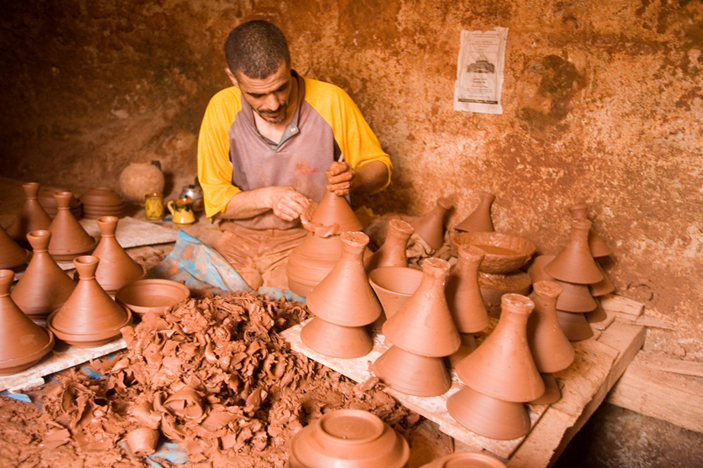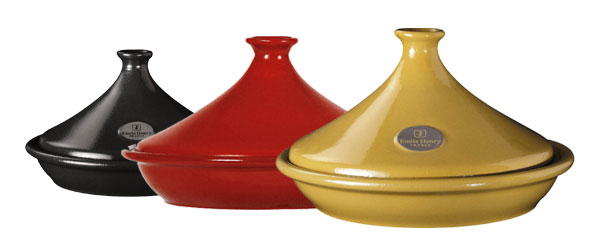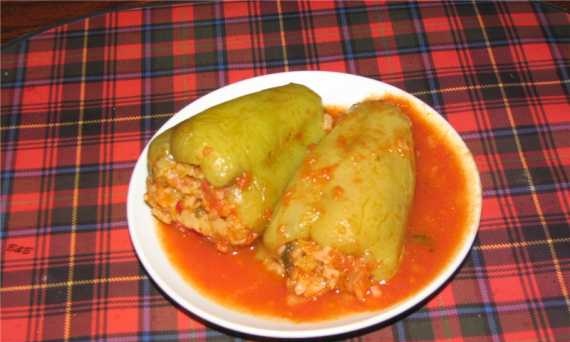About tagine: how to cook in it
In the May issue of the Gastronom magazine my article about tags was published. I have been planning to write about one of my favorite dishes to my favorite community for a long time, and finally, I repay it. I'll tell you about the Moroccan tagine.
Moroccan tagine is spicy and savory, sweet and aromatic, with a sauce as thick as syrup. This is a dish of the most tender meat, fish or vegetables stewed to perfection in a thick buttery sauce, with the addition of fruits, herbs, spices, often honey and chili. The classic tagine is lamb stew with dried fruits, chicken with salted lemons and green olives, duck with dates and honey, and fish cooked with fresh tomatoes, lemon and cilantro.
Today we can enjoy tagine thanks to the Berbers, the indigenous people of North Africa and Egypt. Although tagine is a Berber dish, other peoples living in Morocco at different times have influenced its taste and preparation. These are the Arabs and the descendants of the Mauritanians who migrated from Andalusia, and the Sephardic Jews, and the French colonialists.
By the way, in Tunisia they also cook tagine, but of a completely different kind. Tunisian tagine is more like Italian fritata, or, in our opinion, casserole.
Sit back in the chair and listen to my story about the Moroccan tagine. Having tasted this dish once, I fell in love with it unconditionally and forever. My home was filled with books on Moroccan cuisine and tagines of different colors and sizes. Don't be confused by the abundance of the word “tagine” in the story. The thing is that tagine is not only a dish, but also a dish in which it is cooked. The dishes are very unusual and beautiful. There is something fabulous about her. Note the domed cover. It is not only decorative, it has a lot of meaning. Tazhin is an excellent stewing dish. And all because thanks to the dome-shaped cover, a special vapor condensation is obtained. Tazhin is cooked for a long time and over low heat. Steam, saturated with spice aromas, rises, condenses on the walls of the dome and flows back onto the ingredients. Thus, there is a constant circulation of moisture inside the tagine. Thanks to this process, so that you do not cook in tagine, everything turns out to be unusually tender and juicy, enveloped in fragrant steam.

 Real Moroccan tagines are made from clay.
Real Moroccan tagines are made from clay. Further tagine can be glazed (doused) and even painted. Or it may be completely unprocessed. For cooking, you will need the most common tagine. Patterns are optional. If you manage to get a real Moroccan specimen, be sure to soak it in water overnight. This will reduce the risk of cracking. Unglazed dishes are good because they absorb spices and oils, so every time your tagines will be tastier. When choosing a tagine, make sure it has a very thick and heavy bottom. Otherwise, it will inevitably crack. Moroccans traditionally cook tagines on smoldering coals. If you have a gas stove, be sure to buy a divider. If you have glass ceramics, then choosing a tagine with a thick bottom, use it very carefully.

Although for making tagine at home, especially on glass ceramics, it is still preferable to buy French-made tagine. Our stores are replete with tags of famous and very high quality brands Emile Henry and Staub, Le Creuset. These brands will offer you heat-resistant ceramics or enamelled cast iron. Cast iron is good because meat can be fried on it before stewing.In the north, in cities like Tangier and Casablanca, where Spanish and French influences on local cuisine are evident, the meat is pre-fried. In Fez and Marrakech, tagines are often prepared by simply putting all the ingredients together and adding a little water, and at the end of the cooking oil.

One more nuance. There should be a hole in the dome of the correct tagine for steam to escape (in the photo you can see where the hole should be). Otherwise, the liquid will try to "escape" through the gap between the tagine base and its lid. If your tagine doesn't have a hole, take it to a watchmaker or jeweler. With trembling hands, he will drill a hole several millimeters in diameter for you. I have done this operation with all my tagines. I don't have many, no less than 5! :) Yes, I'm a fan.
For serving, you should choose a beautiful decorative tagine. You put the finished dish into it. Decorative tagine can be painted, can be with chased silver and even with semi-precious stones. The beauty is so breathtaking!

After you have prepared your chosen tagine and washed the dishes themselves, be sure to leave them to dry overnight without covering the base with a lid. Otherwise, mold will start. This applies not only to authentic tagines, but also to ceramic ones. Cast iron (and enameled) base, I advise you to periodically lubricate with vegetable oil and ignite on the stove.
Let's move on to the secrets of cooking.
First, let's
let's get a little familiar with the theory.
What do we do when we prepare tagine? We stew, be it meat, poultry, fish.
Braising is the process of cooking small pieces of meat with a subtle boil. Sometimes the meat is pre-fried until golden brown and then stewed. Stew is also different in that it is usually served in a sauce made from the liquid in which it was stewed. This liquid can be water, broth, and even wine. The advantages of a liquid are that it allows you to quickly transport heat and distribute it evenly. Its temperature can be easily adjusted according to the wishes of the cook, it can acquire taste and transfer it, thereby becoming a sauce. But unlike butter, liquid cannot heat up enough to give the meat the flavor and aroma of roasted meat. Therefore, often before stewing, the meat is fried. It doesn't matter what you are stewing, it is important that the temperature of the liquid does not exceed 80 degrees. Then the top of the meat is not overcooked.
Tagine can be prepared not only from meat, but also from poultry, fish and seafood and vegetables.
When it comes to meat, the cheaper and tougher parts are traditionally chosen. Extinguishing for a long time will make them melt in your mouth. Lamb in tagine can languish all day. This requires almost no effort on your part! In the morning, put the spiced lamb in the tagine, add a little liquid and simmer all day over very low heat. Lamb neck or shanks are ideal for these purposes. Add fruits, vegetables, olives of your choice 30 minutes before the end of cooking.
Poultry and fish do not need such a long cooking time, so an hour and an hour and a half is enough for chicken, and a maximum of 40 minutes for fish. Shrimp should not be cooked for a long time, otherwise they will become rubbery. Strictly speaking, shrimp tagine does not make much sense. Although once I cooked this option, it was quite good.

Spices traditional for Moroccan cuisine are ginger, cinnamon, saffron, turmeric, cumin, coriander, hot pepper and, of course, Raz el Hanut. Since El Hanut translates from Arabic as "head of the store", that is, the most important spice. Its composition may vary, each seller has his own secret, which he will never share with you. To make Raz el Hanuta at home, mix in a mill: a cinnamon stick, 1 tbsp. l. sesame seeds, 1 tbsp. l. ground ginger, 15 black peppercorns, 8 allspice peas, 1 tsp. fennel seeds, 1 tsp. freshly grated nutmeg, 1 tsp. coriander seeds, 8 whole clove buds, seeds from 8 cardamom capsules, 1/2 tsp. whole cumin seeds, 1/2 tsp.ground red pepper, a pinch of macis.
The combination of meat and fruits (including dried fruits) is very unusual in Moroccan cuisine. Please don't be conservative, this is delicious!
Most often, when cooking tagine, onions are first fried, spices are added to it, then meat or fish. Vegetables or fruits are usually added towards the end of cooking. It all depends on the recipe. During cooking, you will be asked the question "Should I add liquid?". Adapted recipes always include water or broth in the ingredients list. I have been looking for an answer to the question "Is it necessary?" I even took a master class from the Moroccan chef Aziz. Adding liquid is not prohibited. But adding it costs very little. The thing is that the meat, fish, vegetables themselves give off juices. At the end of cooking, you should have a very thick syrupy sauce. If you add water, it will become too runny and dilute the natural flavor of the meat and spices. After all, everything tastes better in its own juice!

Another essential ingredient in many tagine recipes is salted lemons. Basically, these lemons are fermented in brine. Sometimes spices are added to the solution. Although Aziz believes this is not authentic pampering, no spices are needed. Lemons are very easy to make yourself. The only downside to home-made is that you have to wait a month before using them. These lemons are good not only in tagines, but also in salads and in couscous.
If you are not yet ripe for traditional crockery, try making tagine in a cast iron deep skillet or cocotte maker. I promise you'll soon want to get the right traditional cookware!
I suggest you start your acquaintance with this cuisine with incredibly tasty recipes that I have tried many times. You will find all these recipes in my catalog. Here I want to show just one recipe for clarity. This is my favorite tagine!
 Chicken Tagine with Caramelized Fruit
Chicken Tagine with Caramelized Fruit Ingredients:
1 chicken (1.5 kg)
1 apple
1 pear
8-10 shallots
1 onion
3 tbsp. l. vegetable oil
2 cinnamon sticks
ground cinnamon for decoration
1 tbsp. l. grated ginger
2 tbsp. l. sesame
200 ml. saffron water
2 tbsp. l. vegetable oil
1 bunch of cilantro tied with white thread
2 tbsp. l. honey
20 g butter
30 ml rose water (optional)
salt, pepper to taste
Cut the chicken into 8 pieces. Heat the vegetable oil in the base of the tagine. Cut the onion into cubes and fry in oil until slightly golden brown. Add to the onion: chicken, cilantro, ginger, cinnamon sticks, salt, pepper and saffron water. Close the tagine with a lid, and simmer everything over low heat for 45 minutes.
Peel the apples and pears, cut into quarters and remove the cores. Melt the butter in a frying pan. Add honey, stir. Put the fruits in the pan and caramelize them. The fruit should be covered with honey on all sides, acquire a beautiful golden color and a light crust. Drizzle the caramelized fruit with rose water (if used) and let the liquid boil. Sprinkle the fruit with cinnamon.
Pour boiling water over the shallots, leave for 5-10 minutes. This makes it easier to cleanse. Heat vegetable oil in a skillet, caramelize the shallots in it for 10 minutes, or until browned on all sides.
If desired, the fruit can be caramelized without honey, like shallots.
In a small skillet, gently fry the sesame seeds until light golden brown, stirring constantly so that they do not burn.
Add apples, pears and shallots to the finished chicken. Close the tagine with a lid and simmer for another 15 minutes. Remove the cilantro after 15 minutes.
Decorate the tagine with sesame seeds. You can dip a few pieces of fruit in sesame seeds for beauty. Serve immediately.
If you decide to completely recreate the Moroccan setting, you should gather the whole family around the table and eat the finished dish with your hands, gripping the food with your index, middle and thumb.This is how real Moroccans eat! Oh yeah, and don't forget to serve the hot tortillas to dip in the sauce.
A little about saffron Saffron is the undoubted king of spices and is often added to tagines. It can be used more effectively by making saffron water out of it. The prepared solution can be stored in the refrigerator for 3 to 4 weeks. One teaspoon of saffron strings will yield 250 ml of saffron water.
Making saffron water is easy. For this you need:
1. Heat a frying pan over very low heat, and fry the stamens, stirring constantly for 2-3 minutes, until the saffron turns a deep red color.
2. Immediately transfer the saffron to a mortar, crush into powder. You can use a small bowl and a wooden spoon.
3. Gently pour the powder into a clean jug or glass, without losing a single precious grain, and pour 250 ml of warm water. Close tightly and shake well. Saffron should almost dissolve in water.
4. Let cool and refrigerate. Or use as directed.
 🔗
🔗








